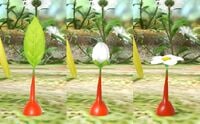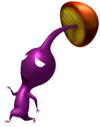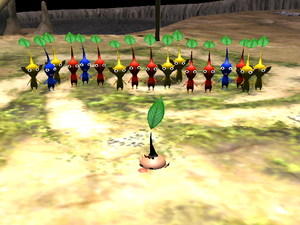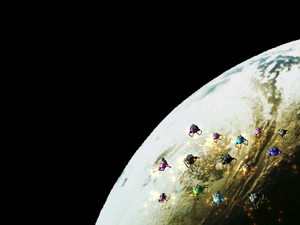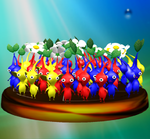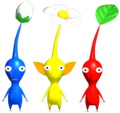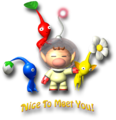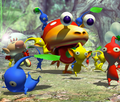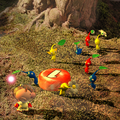Pikmin family
Pikmin (ピクミン?) are a plant-animal life-form first encountered by Captain Olimar when his ship crash-lands on an uncharted planet in Pikmin. The Pikmin are loyal to their leaders, although their criteria for deciding a leader is unclear. They come in a number of different types, each indicating a unique set of attributes that better suit them to different environments and tasks. Most Pikmin are 1.2cm, from the top of the head to the feet, and have a vaguely humanoid shape, allowing them to walk, run, carry and fight. Different types can have different shapes or sizes. Atop any Pikmin's head is a stem, topped with a leaf, bud, or flower, depending on their maturity.
Captain Olimar was noted in Pikmin to wonder, a bit uneasily, why the Pikmin don't attack him, and he speculated that they might see him as a "parental figure"[1]. However, the Antenna Beetle being able to control Pikmin with its sound might prove that it is in fact the whistle that makes Pikmin non-aggressive.
Biology

Although each species has different characteristics, all Pikmin have the same general appearance: a roughly humanoid body shape, two round eyes, two arms and two legs, two hands and two feet – each with three digits – and a tall stem on which a single leaf, bud, or five-petaled flower grows. Their limbs also serve as roots when buried in the ground. In fact, Olimar refers to their entire bodies, save the stems, as ambulatory root structures.[2]
The internal structures of Pikmin are a mystery, but certain things about them can be speculated. Since Pikmin never seem to eat anything, save nectar, they probably have a very simple digestive system, if any. As such, it is likely that Pikmin get a majority of their nutrients from food the Onions break down. Since the Onions are the center of Pikmin reproduction as well, it seems likely that Pikmin are incapable of sexual reproduction. However, in Pikmin flowering Pikmin will sometimes drop seeds when slain in battle, suggesting that they may be able to reproduce asexually, but also that they do not have defined sexes and are hermaphrodites like many plants. Pikmin also have a skeletal system, as seen when electrocuted. Pikmin probably don't have any sort of lungs (however, the Blue Pikmin are observed to have gill structures), but their leaves, buds, and flowers appear to serve as their main means of respiration, since poison gas or water droplets collecting around them suffocates the Pikmin; inversely, walking in shallow water in which their leaf/bud/flower does not touch (as seen in the Shower Room) is fine. When killed, Pikmin disappear and a ghost flies into the air, sometimes after releasing a liquid of the same color as the Pikmin, possibly the Pikmin equivalent to hemolymph or blood – this is best seen when the Cloaking Burrow-nit attacks.
Pikmin start off as seeds ejected from the Onion, which, after landing on the ground, transform into sprouts. A leader must pluck a sprout so that the Pikmin may come out. While idle, the Pikmin's leaves and flowers glow that Pikmin's respective color; that, coupled with a cutscene at the end of Pikmin 2, would suggest that Pikmin are somehow bioluminescent, though what causes this and what function it might serve in the wild has never been explained.
Regular Pikmin are able to carry (at least) ten times their own weight, as evidenced by the ability of Blue Pikmin to lift and toss heavy Purple Pikmin when they are drowning in water. Pikmin are also capable of basic speech and can even be heard saying English phrases like "Ok!" and "Yahoo!" after being plucked from the ground. When in a group they will sometimes sing parts of Ai no Uta in Pikmin 2. If left idle for a long time, Pikmin will moan at each other. From what is heard, it can be assumed that Pikmin language is very simple and primitive.
Stages
- Main article: Maturity.
Pikmin can be divided into three stages. In the first of these, the Pikmin will have a leaf on their stem, which changes to a bud and then a flower as the stage increases. Leaf Pikmin are the slowest and least efficient at performing tasks, but as the stage goes up the movement speed and task efficiency increases.
Pikmin can go up in stage in several ways. The most common way is by being fed nectar. Alternately, they may be left underground before being plucked, where they will gradually mature with time, or, in Pikmin 3, they can be sprayed. When knocked to the ground in battle in Pikmin or Pikmin 2, Pikmin have a chance of losing their maturity and decreaseing in stage. They will never go down in stage in Pikmin 3.
In Pikmin, if a flower Pikmin is shaken off, it will revert to a bud, and the bud will revert to a leaf in the same scenario. In Pikmin 2, however, flower Pikmin revert to leaf Pikmin immediately. Like flower Pikmin, buds can be received when leaf Pikmin are allowed to stay in the ground for a certain amount of time.
Known types
These are the types of Pikmin encountered so far in the Pikmin games.
Red Pikmin
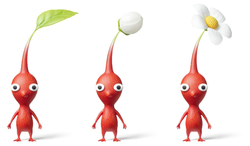
- Main article: Red Pikmin.
Red Pikmin were the first species of Pikmin discovered. Their unique physical feature is their thorn-like noses. These Pikmin are fireproof and are among the types with the strongest attack power in the games they appear in.
Yellow Pikmin
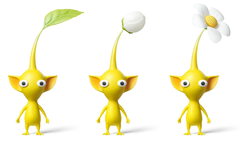
- Main article: Yellow Pikmin.
Yellow Pikmin have large ears. Their ears seem to catch wind currents, so they soar much higher when thrown, and they were discovered in Pikmin 2 to be shockproof. According to Brittany's notes, Yellow Pikmin have a lower body density and weight compared to the other Pikmin.
As electrical hazards were not present during the development of Pikmin, Yellow Pikmin were found to be somewhat lacking in usefulness, as the ability to be thrown high was not that important in general. As a result, Yellow Pikmin became the only Pikmin capable of carrying bomb-rocks, an ability originally designed for all Pikmin types. With carriable bomb-rocks absent in Pikmin 2, the electrical resistance was added, and for Pikmin 3, all types of Pikmin types became able to carry bomb-rocks.
Blue Pikmin
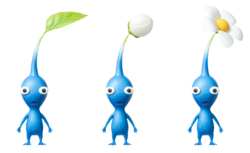
- Main article: Blue Pikmin.
Blue Pikmin have what appear to be mouths. They also have gills on their cheeks, however, they are never seen in-game. These Pikmin, unlike the others, can survive in water and are resistant to water-based attacks. In Pikmin and Pikmin 2, if thrown into water or standing idle, they will save any nearby drowning Pikmin by throwing them back to land.
Purple Pikmin
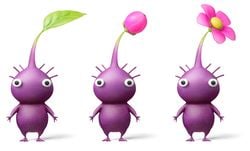
- Main article: Purple Pikmin.
Purple Pikmin are one of the subterranean species of Pikmin discovered in Pikmin 2 and are bulkier and larger than normal Pikmin. They have six wiry hairs growing out of their heads. These Pikmin can cause damage simply by being tossed on enemies (which may also stun the foes), and will actually scoot their bodies in the air to try and land on the enemy if not tossed directly above it. They can also pick up and weigh down objects with the force of 10 Pikmin, but move more slowly, even at the flower stage. In Pikmin 3, their only characteristics are their slow speed and 10-Pikmin carrying strength. Purple Pikmin have magenta flowers, and do not have an Onion.
White Pikmin
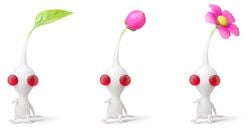
- Main article: White Pikmin.
White Pikmin are another subterranean species of Pikmin discovered in Pikmin 2 which are smaller than normal Pikmin and have red eyes. These Pikmin are resistant to poison, and they seem to also be naturally poisonous, as enemies take heavy damage when they ingest White Pikmin. Their eyes seem to make it possible for them to detect things buried underground and begin to dig them up. These Pikmin are also the fastest, and carry objects much quicker than other Pikmin. In Pikmin 3, their only special traits are their faster speed and ability to poison enemies by being ingested. Like Purple Pikmin, White Pikmin have magenta flowers and lack an Onion.
Rock Pikmin
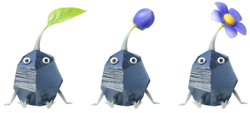
- Main article: Rock Pikmin.
Rock Pikmin first appear in Pikmin 3. Unlike most Pikmin types, they do not have a humanoid appearance, but rather are shaped like an irregular hunk of rock. They have indigo flowers. Rock Pikmin are capable of causing damage to certain types of hard obstacles and enemies that cannot be damaged by other Pikmin. They are immune to being crushed or skewered. Rock Pikmin do the highest damage to an enemy if thrown, but cannot latch onto enemies and deal less damage when regularly attacking.
Winged Pikmin

- Main article: Winged Pikmin.
Winged Pikmin first appear in Pikmin 3 alongside Rock Pikmin. They are pink with large blue eyes, which are similar to those of White Pikmin, and have indigo flowers like Rock Pikmin. They possess insect-like wings, and have the ability to hover over obstacles and carry objects over water. Their attack is slightly weaker than other Pikmin and they will fly upwards when thrown; however, can only reach higher places if ordered to charge, reaching the same height as Red Pikmin when thrown normally. Winged Pikmin are immune to most ground-based attacks and enemies. However, if knocked onto the ground and stunned, they become vulnerable to said attacks.
Bulbmin
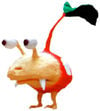
- Main article: Bulbmin.
Bulbmin are the third species of subterranean Pikmin found exclusively in Pikmin 2 and are a combination of a parasitic Pikmin and a juvenile Bulborb. They are immune to all natural hazards thanks to the Bulborb's anatomy. Although they can carry objects and flower as normal Pikmin do, they are unable to leave the caves in which they are found. The actual appearance of the parasitic Pikmin alone is unknown. These Pikmin do not make a re-appearance in Pikmin 3.
Mushroom Pikmin
- Main article: Mushroom Pikmin.
Mushroom Pikmin, or "Puffmin", are not a separate species, but rather the result of allowing Pikmin to be exposed to the spore cloud attack from a Puffstool. Pikmin affected by the cloud turn purple, grow mushrooms on their heads, and turn against Olimar and other unaffected Pikmin. Mushroom Pikmin can be cured by shaking them off Olimar, attacking one with an unaffected Pikmin, defeating the Puffstool, or simply waiting for the effect to wear off. Both Mushroom Pikmin and the Puffstool are exclusive to Pikmin.
Mushroom Pikmin can sometimes turn against the Puffstool due to a certain glitch, and can sometimes even be controlled by Olimar, depending on exactly how the glitch is carried out.
Olimar as a Pikmin
|
Warning: the following text contains major spoilers about the ending of Pikmin.
|
|---|
Captain Olimar becomes a Pikmin hybrid in the bad "alternative" ending of Pikmin, where the S.S. Dolphin fails to take off and crashes on the planet again; Olimar is then carried to the red Onion by some Pikmin and ejected as a seed consisting of only his head and a small stem with leaf. Judging by the sounds and visual effects, he appears to flourish to his former size similar to the way Pikmin first grow. |
Undiscovered species
|
Warning: the following text contains major spoilers about the ending of Pikmin.
|
|---|
|
If the player gathers every ship part in the first Pikmin game, they will see several different colors of Onions on the ending cutscene. These include purple, orange, black, pink, green, and cyan. Although Purple Pikmin are discovered in Pikmin 2, they were introduced without an Onion. Winged Pikmin are later discovered in Pikmin 3, accompanied by a pink Onion. Rock Onions are also discovered in Pikmin 3, but are a bit more dark gray than black. Therefore, it is currently unknown whether the rest of these colors will appear in future games, or if they exist solely to add aesthetic value to the ending cinematic. |
Extinction
- Main article: Pikmin extinction.
Pikmin extinction occurs when every last Pikmin of a type is lost. Depending on the number of Pikmin, the game, and the location, the day can ends straight away, and on the following day the affected Onions each produce a single seed, the cave can be exited immediately, or the Onions can produce seeds right after the last Pikmin is gone.
In Pikmin, the following is Olimar's journal entry on the first day extinction occurs: The Pikmin have all perished because of my own carelessness. I am an utter disgrace as a leader... How can I continue to collect parts without them? Still the Onions join me in low orbit, as if this Pikmin extinction had never happened. I shan't sleep tonight...
Habits
Pikmin following leaders are prone to stumbling every now and then, and occasionally fall over completely, in the first two Pikmin games. This happens much more frequently in Pikmin, and, further complicated by a mass of 100 Pikmin walking together, can sometimes pose a serious problem, reducing general maneuverability. In Pikmin 2, Pikmin trip much less frequently, but still stumble often. During a retreat from a beast, a Pikmin that trips is likely to be eaten or squashed by the creature; this is especially aggravating during zero-death runs. Sometimes, it may be hard to notice if a Pikmin trips, leading to lone Pikmin becoming separated from the group.
Pikmin can be seen interacting with each other when idle. These actions include grooming each other, communicating in high pitched whimpers, waving, and playing abstract games. In Pikmin 2, if 20 of each type Pikmin is called into one group, they will hum a portion of the song Ai no Uta. This suggests that they have a highly developed and friendly social structure. Pikmin will also watch leaders move around when stationary, indicating that they are very curious creatures, and can be seen to mimic the idle motions of those leaders. All idle Pikmin have a natural tendency to perform nearby tasks, such as, for Blue Pikmin, running into water to save drowning Pikmin even if it is infested with enemies.
In Pikmin, if Pikmin are told to go in an Onion, they will follow a path to go there if they cannot make it in a straight line.[3] This behavior is rarely seen, given that the area layouts seldom allow Pikmin to be unable to enter the Onion from a straight walk while also being under the control of a leader that is close enough to the Onion's beam. It is currently unknown if Pikmin exhibit this behavior in Pikmin 2 or Pikmin 3.
In Pikmin 3, having a group of sixty six or less Pikmin of any type and moving the cursor around the Pikmin or around the group will make some Pikmin look at the cursor, although this may just be aesthetic. For Winged Pikmin, this only works if they are walking. Interestingly, leaders do not display this behavior.
Likeliness to die
In Pikmin and Pikmin 2, some Pikmin are more likely to die than others, due to engine limitations. It boils down to how the games check which Pikmin should die for any given attack.[4][5] In Pikmin 3 and Hey! Pikmin, although it isn't clear, it seems that the Pikmin closest to the center of the attack are the ones that get hit by it.
The general idea is that each game keeps a list of loaded Pikmin in memory. This list can fit 100 entries, and normally, it starts off empty. When a Pikmin is loaded into memory, it fills in the next vacant slot. In the case of an empty list, this is slot 0. The second Pikmin to be called out fills slot 1, and so on. When an enemy attacks to eat, the game checks every loaded Pikmin to see if it is colliding with the mouth's hitbox, and starts checking slot 0, then slot 1, etc.
General case
Suppose that a day starts, 100 Pikmin are taken out from Onions, and they are all bundled together within reach of a Red Bulborb's bite hitbox, which is an attack that will only chomp 5 Pikmin. The game will check the Pikmin in slot 0, confirm that it is within reach, and add it to the list of eating victims. It would then check slot 1, confirm that that one is as well, and add it. It would check slot 2, confirm that as well, and add it. It would do the same for slots 3 and 4. At this point, since it already added 5 Pikmin to the list of eating victims, it would stop checking, and would let the Bulborb's attack finish with those 5 Pikmin captured in its mouth. In this case, the five Pikmin that fell victim to the attack were the first five ones that got pulled out of the Onions. This means that, when starting a day normally, the first Pikmin that left the Onion are more likely to get eaten.
Cases with no "first" Pikmin
Above is what happens in the most plain cases, but there are times when the player enters an area or cave with a lot of Pikmin, and the player doesn't control the order in which Pikmin load.
In Pikmin, if the player lands on an area with buried Pikmin, those Pikmin are actually not a part of the list of Pikmin, but rather, a list of seeds. A Pikmin is only created and added to the list when it is plucked.
In the case of Pikmin 2, this scenario happens when a cave sublevel is entered, when the player exits a cave and lands on an overworld area along with the Pikmin that escaped, or when the player enters an area that already has buried Pikmin. The Pikmin here are all truly loaded outside of the player's control. The game does however follow an algorithm to decide how to place Pikmin in the area and to fill in the Pikmin list slots:
- Gather information about what Pikmin should be loaded when the area/cave loads. It does not matter how it is sorted.
- For every type of Pikmin declared in the game:
- Check the compiled information to see how many Pikmin of this type must be spawned.
- Spawn that number of Pikmin.
Internally, Pikmin types are declared with Blue Pikmin first. Then comes Red, Yellow, Purple, White, Bulbmin, and Pikpik carrot. The reasons for this seemingly random order are not known. So, in scenarios where the game has to load multiple Pikmin of different types "at once", Blue Pikmin will be loaded first, meaning they will fill in the first Pikmin slots. If players find themselves in one of these scenarios then Blue Pikmin will be more likely to be eaten, since hitboxes that catch multiple Pikmin will pick the Blue Pikmin first.
As a matter of fact, some players have noticed that, in Pikmin 2, Blue Pikmin seem more likely to die than other types.[6][7] This is exactly why.
Naming
Captain Olimar named these creatures "Pikmin" because of their resemblance to a vegetable he eats in Hocotate, the pikpik carrots. The word "Pikmin" is never written with a lowercase "P", and the plural is still written as "Pikmin". Interestingly, some parts of some games do not capitalize the word that defines the type of Pikmin, but capitalize the word "Pikmin" itself, whereas others might capitalize both words. For instance, Olimar's voyage log may write "red Pikmin",[8] while Alph and Brittany's dialogues might have the text "Red Pikmin".[9].
The game was named after the Pikmin. Sometimes, Pikmin are also referred to as "piki", especially internally inside a game's files, as proven by the Honeywisp's Japanese name being ピキマキ? (lit.: "Piki Maki (Pikmin Fuel)"), the term "piki park" in animtest, and the folder /dataDir/pikis in Pikmin's file structure. Likewise, they are sometimes referred to as "pikumin" or "piku", like in Hey! Pikmin's internal names for the Coppeller that carries Pikmin (enemy_carry_piku). In earlier versions of the game, a Pikmin would be referred to as a "pikmin", with a lowercase "p", and the plural would be several "pikmins".[10]
Names in other languages
| Language | Name | Meaning | Notes |
|---|---|---|---|
| 皮克敏 / 皮克敏 | Pikmin | Names taken from Super Smash Bros. Ultimate website. Note that the fighter is called 皮克敏&歐利瑪 / 皮克敏&欧力马 Pikmin & Olimar just like in Japanese | |
| Pikmin | |||
| Pikmin | |||
| Pikmin | |||
| Pikmin | |||
| 피크민 pikeumin |
Pikmin | ||
| Pikmin | |||
| Pikmin | |||
| Пикмин Pikmin | Transcription of English name | In sentences it's always spelled in lower case and is inflected in its proper grammar case and plural |
In Super Smash Bros. Melee
The Pikmin appear as a trophy in Super Smash Bros. Melee.
Gallery
Pikmin
Pikmin fighting a Red Bulborb.
Pikmin climbing on some horsetails.
Early screenshot showing a multitude of Pikmin.
Pikmin 2
- Pikmin 2 promo lily pad.jpeg
Wallpaper of a Pikmin of each type on a lily pad.
Pikmin 3
- Pikmin3Promo4.png
Alph leading the Pikmin away from a Red Bulborb.
Super Smash Bros. series
Olimar, Alph and every Pikmin variety (excluding Rock) in Super Smash Bros. for Wii U.
Trivia
- Winged Pikmin have dark stripes on their bodies which make them resemble bees. This color pattern makes their bodies non-monochromatic, a trait uncommon in most Pikmin types. White Pikmin also seem to have this trait to a certain extent, as they exhibit a purplish tint at the ends of their limbs.
- Originally, Red Pikmin and Blue Pikmin were able to hold bomb-rocks along with the Yellow Pikmin. Nintendo EAD eventually scrapped the idea (most likely due to Yellow Pikmin not having use of their high throw ability often); however, it resurfaces in the third game.
- The first five members of the Pikmin family (from Pikmin to Pikmin 2, not including Mushroom Pikmin or Bulbmin) appear in the Wii to Wii U data transfer app, in which they "carry" the software from the Wii SD card to the Wii U console.
- Pikmin resemble a legend about the mandrake plant, a plant whose roots can sometimes resemble a human body. The legend says that if one uproots a mandrake plant, it will be their servant. However, it is also said that if picked, it will emit a scream powerful enough to kill its picker, so it was recommended to form a strategy for picking it, like tying it to a dog.
- Each of the first 5 Pikmin in Pikmin 2 represent the 5 common senses:
- Smell: Red Pikmin have prominent noses.
- Taste: Blue Pikmin have visible mouths, unlike the others.
- Hearing: Yellow Pikmin have prominent ears.
- Touch: Purple Pikmin have feeler-like hairs atop their head.
- Sight: White Pikmin have absurdly large eyes.
- In addition to this, the Onion-owning Pikmin seem to correspond with the Elements of Nature:
- Red: Fire
- Blue: Water
- Rock: Earth
- Winged: Air
- Yellow: Aether
- In Pikmin 3, Rock, Winged, and Yellow Pikmin have their own voice, different from the other types of Pikmin. In Pikmin 2, Purple and White Pikmin have their own voice during their introduction cutscene. However, they have the same voice as other Pikmin types during normal gameplay.
- In the Pikmin Short Movies, Purple Pikmin have a deeper voice than the other types, as seen in the Treasure in a Bottle scene where three Blue Pikmin and one Purple Pikmin chase after a butterfly.
- Despite their flowers being indigo in-game, the flowers of Winged and Rock Pikmin are blue in some early concept art.
- The Pikmin appear in some games and media outside of the franchise as cameos.
- For an unknown reason, in Pikmin 2, it is impossible to have 100 Pikmin buried in the same area or sublevel, if the Pikmin in question were buried by an enemy. The last Pikmin will simply get knocked back (in the case of a Mamuta)[11] or stay idle (in the case of a Swooping Snitchbug)[12]. Attempting to get 100 seeds via delivering items to an Onion is possible, though.
- The Pikmin types that are better in combat are always found before any other types. In Pikmin, these are the Red Pikmin, in Pikmin 2, Red Pikmin and Purple Pikmin, and in Pikmin 3, Red Pikmin and Rock Pikmin.
- The Pikmin are voiced by Hajime Wakai.[13][14]
- In Hey! Pikmin, it's implied by the S.S. Dolphin II that the Pikmin appear in several planets.[15]
See also
References
- ^ “When I see the Pikmin engaged in fierce battle with other creatures of this world, I often grow uneasy wondering why they never attack me... Could it be that they actually view me as a parental figure? A strange, disturbing thought...” – Captain Olimar in his voyage log
- ^ “Like Pikmin, the creeping chrysanthemum is a member of a group of creatures with ambulatory root structures. This creature is known as a "mimic," but because it is actually a form of plant, this label is not entirely accurate. For unknown reasons, the creeping chrysanthemum's mimicry does not fool Pikmin, perhaps because they share a similar heritage. It relies on preying upon other creatures to provide sustenance, so it has no need of leaves for photosynthesis. Generally speaking, the role of plants within an ecosystem is as a producer species, and thus plants are generally found at the bottom of the food pyramid. However, on this strange planet the line between producer plants and consumer plants is blurred.” – Captain Olimar in his notes for the Creeping Chrysanthemum
- ^ YouTube video showing the Pikmin following a path in order to enter the Onion
- ^ YouTube video explaining what Pikmin are more likely to die in Pikmin
- ^ YouTube video explaining what Pikmin are more likely to die in Pikmin 2
- ^ Why do blue pikmin get eaten the most??? on IGN Boards, published on October 18th, 2008, retrieved on August 15th, 2017
- ^ Blue pikmin get eaten...alot on Pikipedia, published on February 9th, 2008, retrieved on August 15th, 2017
- ^ “Fire should be a natural enemy of the Pikmin, but on closer examination, I've found red Pikmin to be impervious to it. It is fascinating. The reds continue through the flames, completely oblivious to any Pikmin burning around them...” – Captain Olimar in his voyage log for the fire hazard
- ^ “Come to think of it, Alph, you've been with the Red Pikmin since crash-landing here, right?” – Brittany in a dialog with Alph about Red Pikmin, in the European region of Pikmin 3
- ^ E3 2001 Tech Demo Show Off
- ^ YouTube video showing it is impossible for a Mamuta to bury more than 99 Pikmin
- ^ YouTube video showing it is impossible for a Swooping Snitchbug to bury more than 99 Pikmin
- ^ Pikmin 2 developer interview on Nintendo of Japan, retrieved on April 6th, 2018
- ^ Hajime Wakai on Behind the Voice Actors, retrieved on April 6th, 2018
- ^ “They responded to your whistle! Interesting that their behavior is universal across different planets.” – S.S. Dolphin II in a remark about the Pikmin
| Pikmin | |
|---|---|
| Types | Red Pikmin • Yellow Pikmin • Blue Pikmin • Purple Pikmin • White Pikmin Rock Pikmin • Winged Pikmin • Ice Pikmin • Bulbmin • Glow Pikmin |
| Biology | Candypop Bud • Idle • Maturity • Onion • Flarlic • Pellet Pikmin extinction • Trip • Sprout • Seedling • Soul • Squad |
| Abilities | Carry • Dig • Dodge • Fight • Hide |
| Controls | Charge • Dismiss • Swarm • Pluck • Throw • Whistle |
| Other | Decor Pikmin • Leafling • Mushroom Pikmin • Pikpik carrot |
| Characters | |
|---|---|
| Leaders | Olimar • Louie • The President • Alph • Brittany • Charlie • Rookie Rescue Officer • Oatchi • Moss |
| Rescue Corps | Collin • Shepherd • Russ • Dingo • Yonny • Bernard |
| Ships | S.S. Dolphin • S.S. Dolphin II • Hocotate ship • S.S. Drake • SPERO • S.S. Beagle • S.S. Shepherd |
| Other | Castaway • Leafling • Minor characters • Pikmin |

